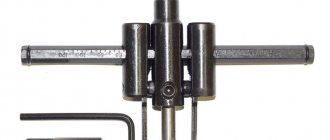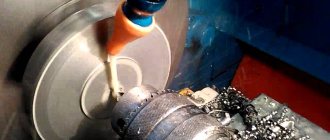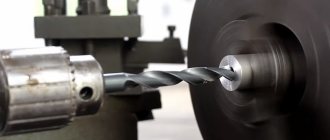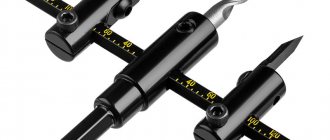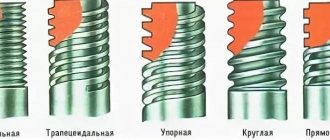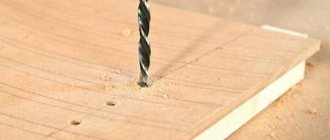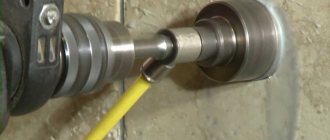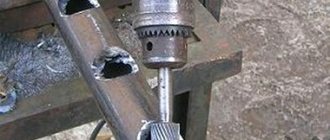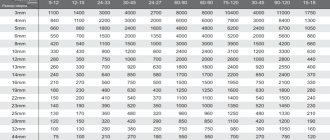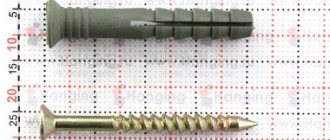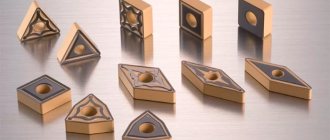In ceramic tiles, which are actively used for finishing the surfaces of walls and floors, it is often necessary to drill round holes of large diameter, which are indispensable when laying communications, as well as when installing electrical sockets, fastening and decorative elements. A tool with which such holes can be made as accurately as possible is a ballerina.
Skillful use of the “ballerina” guarantees an accurate hole with neat edges
What is a ballerina
The cutting tool, commonly called a ballerina, also has a more professional name - “circular adjustable drill with cutters.” The drill is located in the central part of the tool and is used to center the hole. The radius of the circle that the cutters will describe is measured from the center line of this drill.
To equip ballerinas, drills of the first or auger type are used, since a conical tool does not cope well with ceramic materials and can slide off their surface. The result of such slipping can be damage to both the tool itself and the surface of the tile.
Ballerina on tiles differs from a nozzle designed for drilling holes in wood materials
Method of drilling holes with a ballerina
Please note:
Before starting drilling, when the intended hole is marked, mark the drilling center mechanically. For this, a regular drill is used. The ballerina may slip on the tile (at the first touch) and scratch the tile.
The use of hammer drills is prohibited. If you have a multi-mode drill, the hammer function should be disabled. It is recommended to immerse the workpiece in water in advance. There will be no harm to the tile, and there will be much less chipping and dust.
In principle, there are two ways of drilling: before laying the tiles, and on the finished tiled surface.
Drilling individual tiles
The workpiece is placed on a flat surface. The thickness of the backing should allow the center drill to deepen 4-8 mm relative to the main cutting element.
You can hold the tiles with your hands, although it would be better to secure them with clamps. You must be prepared for the fact that after the ballerina passes through, the cut out circle will rotate freely. For control, it is recommended to periodically stop the process and check the depth of the cut.
Drilling a hole in the tile with a ballerina with a basket - expert advice
Types by number of incisors
The design of a ballerina is influenced by the number of incisors with which it is equipped (their number can vary from one to three).
- The design of ballerinas equipped with one cutter has a special adjustable bracket with a tightening screw. To start working with such a tool, use a bracket to move the cutter to the required distance from the axis of the central drill, and then fix its position using a tightening screw.
- The cutting tools of two-cut ballerinas are also located on a bracket, which is motionless. Adjustment of the position of the cutters relative to the axis of the central drill is ensured by movable holders on which clamping screws are installed for fixing the cutting tool. The position of each of the incisors of such a ballerina is set separately, and, of course, their distance from the axis of the central drill must be the same.
- The three-incisor ballerina for tiles and ceramic tiles has the most complex design. The basis of such a tool is a round disk-type platform, in special grooves in which the cutters move. A special scale applied to the body of the device platform in the area of its grooves allows you to accurately set the position of the cutters and, accordingly, obtain holes of the required diameter. The movement of all three cutters of such a device is synchronized, which allows you to quickly, easily, and most importantly, accurately set the position of each tool relative to the axis of the central drill.
The protective basket on some instrument models protects against flying fragments
Modern models of one- and two-incisor ballerinas are also equipped with a scale for determining the exact position of the incisors relative to the axis of the central drill. It should be borne in mind that the accuracy of the holes obtained by a ballerina with such a scale is much higher than when using a simpler tool.
It is necessary to choose a ballerina of a more complex design in cases where it is necessary to drill a large number of holes in ceramic or tiles. A tool equipped with multiple cutters not only improves the productivity of the drilling process, but also creates holes with higher accuracy.
Classification of tools
The tile ballerina looks like a drill, which is located in the very heart of the instrument and performs the function of centering the future hole. The product can be presented in the form of a feather, cone or auger. Attention!
Experts do not recommend using a conical ballerina to carve holes in tiles. There is a high probability that the drill will slip during operation. This can lead to damage to the ceramics and the instrument itself.
Today, ballerinas of the following types are actively used:
- single-cut - this product has a bracket complemented by a screw. It is perpendicular to the drill. When working with the tool, the cutter is extended to the required length and tightened with a screw;
- two-cutters - a second cutter is additionally attached to the bracket. In this case, the screws are placed on the holders themselves. The tool works similarly to the previous one. You will need to extend the incisors to the required length and fix them in this position. But it should be remembered that their distance from the drill must be the same;
- three-incisor ballerinas - ballerinas of this type are a complex product. The cutters are fixed on a round box and move in the grooves. There is a scale on the body of the instrument. It makes it possible to set the size of the future hole.
Attention!
When using a three-cut ballerina, it is important that the product is not loose. The cutters must move synchronously. This ensures smooth cutting of the tiles.
Advantages of ballerinas
Using such a tool during finishing work has many advantages. Let us point out all the advantages of the product:
- Using a ballerina on tiles, you can achieve a perfectly even cut of the tiles. In this case, you can easily avoid chipping the enamel;
- It is possible to make a hole in the tile of the desired size and diameter. To do this, you just need to place the incisors at the required distance and fix them in this position;
- Using a ballerina, you can make a hole in a tile without changing tools. If you use a regular drill, you will need to first make a central hole. And this will take more time and labor;
- One of the advantages is that ballerina’s incisors can be sharpened. For example, when using a drill with crowns, sharpening cannot be done.
Advice!
When cutting tiles, a large number of small pieces of tiles fly off, which can be harmful to health. To prevent this from happening, purchase a tool with a protective grille. There will be a slight difference in price, but if you use such an accessory, then the remains, crumbs and parts of the tile will remain inside the protection and will not harm the worker.
Ballerina with protective grille
Design Features
The design of any ballerina includes the following elements:
- a rod with which such a device is fixed in the chuck of an electric drill;
- feather-type centering drill;
- adjustable bracket on which the cutting tool is fixed;
- a cutter, the working part of which is coated with diamond sputtering or a carbide plate is brazed.
Ballerina device
When choosing a ballerina to perform work on tiles or ceramic tiles, you should not save money. A high-quality tool, the price of which is significantly higher than that of simpler models, will not only allow you to get the job done efficiently, but will also not ruin the tiles, which may cost even more than the ballerina used to drill them.
Circular drill device
A ballerina drill for wood is made from carbon, tool, and alloy steels, which are not suitable for processing hard materials: metal, tile, porcelain stoneware. But they cut drywall and plastic easily.
The two-incisor ballerina looks like an ordinary compass . But the design is much more complex. The bracket and cylindrical shank are manufactured in one piece. There are two holes in the bracket. A centering drill is installed in one. A rod is installed in the second. Both are secured with screws.
To set the required diameter, the cutters move along the rod. It has a vernier scale on it. The tool holders are also secured with screws. The incisors are shaped like a knife. The oblique edge of the cutter should be directed in the direction of rotation, clockwise.
If the drill becomes dull during operation, it can be easily replaced. If the cutters are dull, then, having the skills to work on a sharpening machine, you can refill them. The shank of the structure is fixed in the chuck of an electric drill. It is worth remembering that the small power of a power tool may not be enough to work with a ballerina, unlike metal drills.
Advantages and disadvantages of use
To drill large-diameter holes in ceramic or tiles, you can use not only a ballerina, but also a number of other devices, which include a core-type tool, a chain saw or a diamond string mounted on a hacksaw. When choosing any of these tools, you should first evaluate the effectiveness of its use.
The main advantage of a ballerina over crowns is the adjustable diameter of the cut hole.
Let's look at the disadvantages of using a ballerina to drill holes.
- When using such a tool for drilling work on tiles, a large number of fragments are formed that can harm the worker. Meanwhile, you can successfully solve this problem if you stick ordinary tape on the surface of the tile that is being drilled, or use a tool with a protective grill for drilling. The cost of the latter is not much higher than the price of conventional models, but it significantly increases the safety of the person who works with it.
- The edge of the hole, which is drilled using a ballerina, is not very neat. This problem is also solved: the tool can be moistened with water or machine oil, and drilling can be performed as carefully as possible and without unnecessary haste.
The most significant advantage of ballerinas is that their use allows you to create holes in a wide range of diameters in ceramic or tiles. Thus, on the modern market there is a tool with which you can make holes whose radius is in the range of 20–90 and 40–130 mm. Accordingly, to determine the diameter of such holes, these values must be multiplied by two. If the main working elements of the ballerina (drill and cutters) are made of high-quality materials, it copes with all its functions quite successfully.
When purchasing a ballerina of any design, you should pay attention to the rigidity of the connection between the rod and the central rod
How the tile cutting process is performed
There is a certain algorithm that should be followed when using a tool for drilling holes in tiles, like a ballerina.
- First of all, on the front side of the tile it is necessary to mark the center of the future hole, for which you can use a regular core.
- The cutter or cutters of the ballerina, which will do the main work of cutting the material, are installed and fixed at the required distance from the axis of the central drill.
- It is advisable to lubricate the area of the tile on which the cut will be made with machine oil. In this case, you should make sure that it does not fall into the center of the circle, which can lead to the drill slipping.
- The drill, located and rotating in the center of the future hole in the tile, must pass through its surface before the cutters, so it must be longer than their protruding part.
- The tile in which the hole is made using a ballerina must be firmly fixed on a flat surface of a wooden board or drywall. To ensure such fixation, you can use ordinary clamps.
- Drilling the hole is carried out at low speeds of the tool, and it is advisable to constantly water the groove formed on the tile with machine oil.
- After the cut in the tile has been made to more than half its thickness, and the central drill has passed through the material being processed, the product is turned over and similar processing is performed on its reverse side.
- The tile is drilled to the end from the back side, and the edge of the resulting hole, which may not be too smooth, is processed using a file, emery cloth or a grinding machine.
Despite the fact that the holes made with the help of a ballerina do not have very smooth edges, it is quite reasonable to use it to perform not too voluminous work. In addition, the uneven edges of the holes will later be hidden by external panels of electrical outlets and other decorative elements.
In conclusion, a visual video about drilling ceramic tiles with a ballerina, as well as those cases when you can use a grinder to cut holes.
